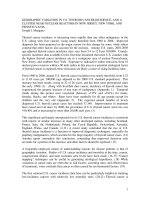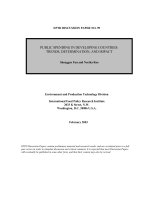RUBBER DOWNSTREAM INDUSTRY DEVELOPMENT IN INDONESIA: CURRENT STATUS, OPPORTUNITIES AND CHALLENGES potx
Bạn đang xem bản rút gọn của tài liệu. Xem và tải ngay bản đầy đủ của tài liệu tại đây (1.19 MB, 29 trang )
1
RUBBER DOWNSTREAM INDUSTRY
DEVELOPMENT IN INDONESIA:
CURRENT STATUS, OPPORTUNITIES AND
CHALLENGES
Nelly Rahman, Uhendi Haris
Bogor Research Center for Rubber Technology
Indonesian Rubber Research Institute
2
INTRODUCTION
Natural rubber is one of the great economic and social function for
Indonesia
no doubt for environment conservation
Rubber export earning in 2008 accounted for US$ 6.057 billion or
about 26% of estate crops export value.
Domestic consumption in Indonesia in 2008 was 414,000 tons
accounted 15.0 % of the total production, (65 % was consumed by
tyre industries).
Development of rubber downstream industry: increasing the added
value, increase the consumption of natural rubber in the country,
reducing imports of rubber goods, increase employment and foreign
exchange savings.
3
CURRENT STATUS
Indonesian rubber planted areas, production and consumption,
2001 – 2008
Item
2001
2002
2003
2004
2005
2006
2007
2008
Area (000) ha 3345 3318 3290 3262 3279 3309 3414 3433
Production (000) tons
(share of the world) (%)
1607
(22.29)
1630
(22.83)
1792
(23.27)
2066
(23.97)
2271
(25.25)
2637
(27.20)
2755
(27.85)
2751
(27.87)
Export (000) tons 1452.7 1497.3 1660.9 1874.3 2023.8 2286.0 2406.7 2295.5
Value (Million US$) 782.1 1038.9 1493.5 2180 2582.5 4320.7 4868.7 6056.6
Domestic consumption
(000) tons
142 145 156 196 221 355 391 414
4
Annual grown of production in Indonesia
5
Rubber Plantation Area Percentage
6
INDONESIAN RUBBER PLANTED AREAS
Smallholders Government-owned Private
Year
Area (000 ha)
7
Indonesia rubber export by type and grade (metric tons),
2002 – 2008
Type and Grade
2002
2003
2004
2005
2006
2007
2008
Latex Concentrate
12,526 12.526 11,755 4,014 8,334 7,610 8,547
(0.75%) (0.75%) (0.63%) (0.20%) (0.36%) (0.32%) (0.37%)
Ribbed Smoked
Sheet
46,165 46,165 145,895 334,125 325,393 275,497 137,755
(2.78%) (2.78%) (7.78%) (16.51%) (14.23%) (11.45%) (6.00%)
Standard Indonesian
Rubber (Technically
Specified Rubber)
1,589,387 1,589,387 1,684,959 1,674,721 1,952,268 2,121,863 2,148,499
(95.69%) (95.69%) (89.90%) (82.75%) (85.40%) (88.16%) (93.60%)
Other types of NR
12,842 12,842 31,652 10,921 3.0 1,786 706
(0.77%) (0.77%) (1.69%) (0.54%) (0.00%) (0.07%) (0.03%)
TOTAL
1,660,920 1,660,920 1,874,261 2,023,781 2,285,967 2,406,756 2,295,459
8
Export performance of Indonesian natural rubber, 2003 – 2008
9
Clasification of rubber goods industry in Indonesia
a. Tyre (bicycle, motorcycle, passenger cars, etc)
b. Engineering rubber goods for industry and automotive
(conveyor belts, automotive component, electronic
component, bearing, etc)
c. Latex goods (glove, condom, rubber thread, balloon, etc)
d. General rubber goods (carpet, footwear, sports goods, etc)
10
Indonesian Rubber Goods Industries
Industry
Amount
Motorcycle and car tyre industries 19
Bicycle tyre industries 7
Engineering rubber goods industries 56
Latex goods industries 51
General rubber goods industries 85
11
Export-import balance of rubber goods in Indonesia
2003 2004 2005 2006 2007
Vol Value Vol Value Vol Value Vol Value Vol Value
(metric
tons)
(million
US$)
(metric
tons)
(million
US$)
(metric
tons)
(million
US$)
(metric
tons)
(million
US$)
(metric
tons)
(million
US$)
Export 282 568 371 757 383 935 416 1126 458 1274
Import 101 229 90 239 105 328 106 390 142 404
Balance 181 340 281 518 278 608 310 735 316 870
12
Export-import balance of rubber goods in Indonesia
0
200
400
600
800
1000
1200
1400
2003 2004 2005 2006 2007
Year
Million US$
Export
Import
Balance
13
Rubber goods trade balance in Indonesia, 2006 – 2008
Type
2006 (million US$) 2007 (million US$) 2008 (million US$)
Export Import Balance Export Import Balance Export Import Balance
Industrial
rubber goods:
Rubber threads
Tubes, pipes,
hoses
17,5
22,4
1,0
51,1
16,5
(28,7)
16,6
3,7
2,5
39,8
14,1
(36,1)
14,0
3,1
3,3
41,5
11,7
(37,4)
Conveyor belts 3,0 22,2 (19,2) 4,5 25,5 (21) 3,1 25,9 (22,8)
Transmission
belts
44,9 13,6 31,3 41,0 16,3 31,5 44,7 18,1 24,5
Tyre (car,
motorcycle,
bicyle)
766,4 198,0 568,4 973,5 781,5 192,0 1,068 18,4 109,6
gloves 152,1 3,9 148,2 163,7 4,3 158,4 211,7 10,3 201,4
others 109,2 271,1 (161,9) 297,6 222,1 75,5 126,9 125,1 1,8
14
Government-owned Rubber Downstream Industries Profile
10 government-owned companies and one a subsidiary company which
runs business on rubber commodity: PTPN I, PTPN II, PTPN III, PTPN V, PTPN
VII PTPN VIII PTPN IX, PTPN XII, PTPN XIII PTPN XIV, and PT Rajawali
Nusantara Indonesia (RNI).
PTPN III, PTPN V, PTPN IX, PTPN XIII, and PT RNI ever and is developing
rubber goods industry.
Company Subsidiary company Product
PTPN III PT IKN
Rubber articles
Master batch
Rubber thread
Resin
PT RNI PT MRB Condom
Disposable syringe
PTPN V and PTPN XIII
share with private company
PT Agrintara Conveyor Belts
15
Rubber Thread is an intermediate product for garment and elastic industry which be used in
combination/ covered with various types of yarn such as polyester, nylon, cotton, etc.
16
Resiprene 35 is cyclized natural rubber
soluble in odorless solvent, particularly in
aliphatic hydrocarbon and cheap blends of
aromatic and aliphatic, suitable for
protective and maintenance coatings and
for marine paints for brushing, rollers and
spray application.
17
Advantages
•Easy to handel
•No Pollution created by carbon black addition
•Shorter mixing times
•No bale cuttter needed
18
OPPORTUNITIES
17.9%
63.4%
0.3%
0.3%
3.8%
6.3%
2.0%
6.1%
Latex, pharmaceutical/hygienic goods
Tyre and related products
Tubes, pipes and hoses
Conveyor belts
V and other belts
Automotive parts
Other industrial rubber products
General rubber products
Export of Indonesian Rubber Products (000 US$) Jan-Nov 2008
Business of natural rubber will continue to grow and sustainable because it supported a variety of
factors including: the use of natural rubber in line with population growth and the raw materials are
renewable.
19
OPPORTUNITIES
2%
47%
16%
5%
3%
15%
2%
10%
Indonesian Import Rubber Products Jan-Nov 2008
Latex, pharmaceutical/hygienic goods
Tyre and related products
Tubes, pipes and hoses
Conveyor belts
V and other belts
Automotive parts
Other industrial rubber goods
General rubber goods
20
OPPORTUNITIES
Export of rubber goods generally good growth in terms of export
volume and value.
Export growth rates are generally higher than import growth.
(
However, in terms of each type of product, there are several rubber
products so that the negative trade balance
).
Positive trade balance is always achieved from the tyre industry
and other industries that require a lot of natural rubber.
rubber goods industry with the main raw material of synthetic
rubber, Indonesia still needs a lot of imports, so that the
negative trade balance, such as conveyor belts industry
21
Import Of Synthetic Rubber
automotive industry and other industries in Indonesia is
growing and is likely to continue to grow.
Type 2006
Jan-Nov
2007
Jan-Nov
2008
Change
(%)
SBR 62,746.4 59,190.0 93,335.9 57.7
BR 42,254.1 38,780.9 50,148.9 29.3
IIR 12,050.0 10,971.1 16,503.5 50.4
CR 4,831.9 4,444.7 5,156.9 16.0
IR 1,119.4 1,066.2 1,244.5 12.8
NBR 3,221.7 2,856.9 9,539.7 133.9
EPDM 5,525.3 5,025.7 8,133.3 61.8
Others 2,780.1 2,549.2 3,615.9 41.8
Total 134,528.9 125,158.5 187,678.6
22
OPPORTUNITIES
The price of natural rubber as a raw material is very fluctuate,
on the other hand rubber goods prices are relatively stable and
even tends to increase.
This opportunity is caught by PTPN by planning to build new
industries or developing the existing rubber downstream
industries to obtain added value or higher profitability
23
CHALLENGES (For Government-owned Rubber Industry/PTPN)
Business of government-owned plantation enterprise (PTPN) may be more
developed and sustainable when integrating the upstream industry with
downstream industries that have high added value.
Balance of exports and imports used to analyze the products to be
developed prospectively. (The products with negative export-import balance :
import substitution, the products with positive export-import balance :
increase the export value).
Development of government-owned rubber downstream industry have two
target programs:
the development of new downstream industries
(motorcycle tyre industry) and the revitalization of rubber downstream
industries that already exist (gloves, rubber threads, conveyor belts).
24
CONCLUSION
Population growth and recovery of the Indonesia
economy will have a positive impact on business
including business on rubber products.
Awareness of people on environment leads to increase
in the use of natural-based products.
Positive prospect on rubber business has to be
responded quickly in order to catch up the opportunity.
By improve the knowledge and skills of human
resources in the technology, equipment and marketing
network, a significant increase in contribution to the
company’s revenue could be expected.
25
IRRDB
IRRI
ACKNOWLEDGMENT









